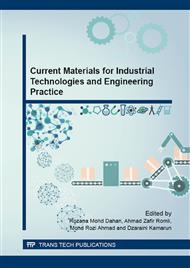[1]
S.Y. Hua, and D.J. Johnson, Research issues on factors influencing the choice of kitting versuslinestocking, International Journal of Production Research, 2010; 48(3), pp.779-800.
DOI: 10.1080/00207540802456802
Google Scholar
[2]
G. Chryssolouris, N. Papakostas, N., D. Mavrikios, A Perspective on Manufacturing Strategy: Produce more with Less, CIRP Journal Manufacturing Science and Technology, 2008; 1(1), p.45–52.
DOI: 10.1016/j.cirpj.2008.06.008
Google Scholar
[3]
G. Chryssolouris, Manufacturing Systems: Theory and Practice, 2nd ed. Springer-Verlag, New York, (2006).
Google Scholar
[4]
M.A. Corakci, An evaluation of kitting systems inlean production, Master thesis, 2008; University Of Boras, Boras.
Google Scholar
[5]
Y.A. Bozer, and L.F. McGinnis, Kitting versus line stocking: a conceptual framework and a descriptivemodel, International Journal of Production Economics, 1992; 28(1), pp.1-19.
DOI: 10.1016/0925-5273(92)90109-k
Google Scholar
[6]
L.L. Kosteand M.K. Malhotra. A theoretical framework for analyzing the dimensions of manufacturingflexibility, Journal of Operations Management, 1999; 18(1), pp.75-93.
Google Scholar
[7]
L. Medbo. Assembly work execution and materials kit functionality in parallel flow assembly systems, International Journal of Industrial Ergonomics, 2003; 31, pp.263-281.
DOI: 10.1016/s0169-8141(02)00220-2
Google Scholar
[8]
A. Caputo and P.M. Pelagagge. A methodology for selecting assembly systems feedingpolicy, Industrial Management & Data Systems, 2011; 111(1), pp.84-112.
DOI: 10.1108/02635571111099749
Google Scholar
[9]
C.J. Sellers and S.Y. Nof. Part kitting in robotic facilities, Material Flow, 1986; 3(1-3), pp.163-174.
Google Scholar
[10]
M.I. Johansson. Kitting systems for small size parts in manual assembly systems, in Pridham, M. and O'Brien, C. (Eds), Production Research: Approaching the 21st Century, Taylor & Francis, London, 1991; pp.225-230.
Google Scholar
[11]
L. Medbo. Materials supply and product descriptions for assembly systems – design andoperation, Dissertation, 1999, Chalmers University of Technology, Go¨teborg.
Google Scholar
[12]
F.Y. Ding and B. Puvitharan. Kitting in just-in-time production, Production &InventoryManagement Journal, 1990; 31(4), pp.25-28.
Google Scholar
[13]
F.Y. Ding. Kitting in JIT production: a kitting project at a tractor plant, IndustrialEngineering, 1992; 24(9), pp.42-43.
Google Scholar
[14]
H. S. Kilic &M. B. Durmusoglu. Design of kitting system in lean-based assembly lines. Assembly Automation, 2012; 32(3), pp.226-234.
DOI: 10.1108/01445151211244357
Google Scholar
[15]
D. Alford, P. Sackettand G. Nelder. Mass customisation – an automotive perspective, International Journal of Production Economics, 2000; 66(1), pp.99-110.
DOI: 10.1016/s0925-5273(99)00093-6
Google Scholar
[16]
R. Hanson, L. Medbo andP. Medbo. Assembly station design: A quantitative comparison of the effects of kitting and continuous supply. Journal of Manufacturing Technology Management, 2012; 23(3), pp.315-327.
DOI: 10.1108/17410381211217399
Google Scholar
[17]
C. Wänström andL. Medbo. The impact of materials feeding design on assembly process performance, Journal of Manufacturing Technology Management, 2009; 20(1), pp.30-51.
DOI: 10.1108/17410380910925398
Google Scholar
[18]
W.P. Neumann and L. Medbo. Ergonomic and technical aspects in the redesign of material supply systems: Big Boxes vs Narrow Bins, International Journal of Industrial Ergonomics, 2010; 40(5), pp.541-548.
DOI: 10.1016/j.ergon.2010.06.004
Google Scholar
[19]
C. Finnsgård, C. Wänström,L. Medbo andW.P. Neumann. Impact of materials exposure on assembly workstation performance. International Journal of Production Research, 2011; 49(24), 7253-7274.
DOI: 10.1080/00207543.2010.503202
Google Scholar
[20]
R. Hanson, Effects of using minomi in in-plant materials supply, Journal of Manufacturing Technology Management, 2011; 22(1), pp.90-106.
DOI: 10.1108/17410381111099824
Google Scholar


